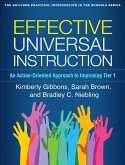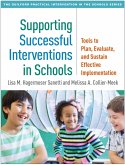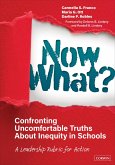Rachel Cohen Losoff, Kelly Broxterman
Transforming Schools
A Problem-Solving Approach to School Change
Schade – dieser Artikel ist leider ausverkauft. Sobald wir wissen, ob und wann der Artikel wieder verfügbar ist, informieren wir Sie an dieser Stelle.
Rachel Cohen Losoff, Kelly Broxterman
Transforming Schools
A Problem-Solving Approach to School Change
- Broschiertes Buch
- Merkliste
- Auf die Merkliste
- Bewerten Bewerten
- Teilen
- Produkt teilen
- Produkterinnerung
- Produkterinnerung
Presenting a unique team-based problem-solving model, this book shows how to turn K-8 school change from a daunting prospect into an achievable goal supported by a concrete plan. A framework is provided for addressing any schoolwide academic or behavior issue, from reading or math problems to concerns about school safety or tardiness. Four clear-cut steps are described: problem identification, problem analysis, plan development, and plan implementation/evaluation.
Andere Kunden interessierten sich auch für
![Effective Universal Instruction Effective Universal Instruction]() Kimberly Gibbons (United States University of Minnesota)Effective Universal Instruction48,99 €
Kimberly Gibbons (United States University of Minnesota)Effective Universal Instruction48,99 €![Transforming Schools Transforming Schools]() Professor Miranda Jefferson (Catholic Education Office, Parramatta,Transforming Schools43,99 €
Professor Miranda Jefferson (Catholic Education Office, Parramatta,Transforming Schools43,99 €![Developing Inviting Schools Developing Inviting Schools]() William W. PurkeyDeveloping Inviting Schools35,99 €
William W. PurkeyDeveloping Inviting Schools35,99 €![Supporting Successful Interventions in Schools Supporting Successful Interventions in Schools]() Lisa M Hagermoser SanettiSupporting Successful Interventions in Schools43,99 €
Lisa M Hagermoser SanettiSupporting Successful Interventions in Schools43,99 €![Safe and Healthy Schools Safe and Healthy Schools]() Jeffrey R. Sprague (United States University of Oregon)Safe and Healthy Schools43,99 €
Jeffrey R. Sprague (United States University of Oregon)Safe and Healthy Schools43,99 €![Now What? Confronting Uncomfortable Truths about Inequity in Schools Now What? Confronting Uncomfortable Truths about Inequity in Schools]() Carmella S. FrancoNow What? Confronting Uncomfortable Truths about Inequity in Schools40,99 €
Carmella S. FrancoNow What? Confronting Uncomfortable Truths about Inequity in Schools40,99 €![Educating for Purposeful Life Educating for Purposeful Life]() S David BrazerEducating for Purposeful Life37,99 €
S David BrazerEducating for Purposeful Life37,99 €-
Presenting a unique team-based problem-solving model, this book shows how to turn K-8 school change from a daunting prospect into an achievable goal supported by a concrete plan. A framework is provided for addressing any schoolwide academic or behavior issue, from reading or math problems to concerns about school safety or tardiness. Four clear-cut steps are described: problem identification, problem analysis, plan development, and plan implementation/evaluation.
Produktdetails
- Produktdetails
- Verlag: Guilford Publications
- Seitenzahl: 245
- Erscheinungstermin: 12. Juni 2017
- Englisch
- Abmessung: 264mm x 203mm x 13mm
- Gewicht: 499g
- ISBN-13: 9781462529575
- ISBN-10: 1462529577
- Artikelnr.: 45671466
- Herstellerkennzeichnung
- Libri GmbH
- Europaallee 1
- 36244 Bad Hersfeld
- gpsr@libri.de
- Verlag: Guilford Publications
- Seitenzahl: 245
- Erscheinungstermin: 12. Juni 2017
- Englisch
- Abmessung: 264mm x 203mm x 13mm
- Gewicht: 499g
- ISBN-13: 9781462529575
- ISBN-10: 1462529577
- Artikelnr.: 45671466
- Herstellerkennzeichnung
- Libri GmbH
- Europaallee 1
- 36244 Bad Hersfeld
- gpsr@libri.de
Rachel Cohen Losoff, PhD, NCSP, is Associate Professor in the School Psychology Department at The Chicago School of Professional Psychology, where she teaches courses in systems theory and change and is involved in a multi-year grant to implement the problem-solving model presented in Transforming Schools. Her research and publications focus on the factors that influence the implementation of a systems-level change. Prior to her academic appointment, Dr. Losoff worked as a school psychologist and systems change agent in several elementary schools in the Chicago Public Schools and in two suburban middle schools. Kelly Broxterman, PhD, NCSP (formerly Kelly McGraw), is Associate Professor in the School Psychology Department at The Chicago School of Professional Psychology. She facilitates a multi-year grant to implement the problem-solving model presented in Transforming Schools in a high-needs school, and is a lead coach for the Illinois MTSS Network. She formerly worked as a school psychologist and district trainer.Dr. Broxterman teaches courses in systems theory and change and conducts research on the factors that influence the implementation of a systems-levelchange. She is the coauthor of RTI Team Building: Effective Collaboration and Data-Based Decision Making and RTI in the Classroom: Guidelines and Recipes for Success.
I. Introduction
1. School Change: What You Need to Know
2. The Systems Problem-Solving Model
3. Getting Started
II. Problem Identification
4. An Overview of Problem Identification
5. Academic Application: Addressing Reading in a Rural Elementary School
6. Behavior Application: Addressing Tardiness in an Urban K-8 School
7. Frequently Asked Questions about Problem Identification
III. Problem Analysis
8. An Overview of Problem Analysis
9. Academic Application: Addressing Reading in a Rural Elementary School
10. Behavior Application: Addressing Tardiness in an Urban K-8 School
11. Frequently Asked Questions about Problem Analysis
IV. Plan Development/Plan Evaluation
12. An Overview of Plan Development/Plan Evaluation
13. Academic Application: Addressing Reading in a Rural Elementary School
14. Behavior Application: Addressing Tardiness in an Urban K-8 School
15. Frequently Asked Questions about Plan Development/Plan Evaluation
V. Conclusion
16. Tips for Successful Systems Implementation
Appendices
A. Reproducible Forms
B. Ask Bright Spot Questions-Long Form
C. Environment, Curriculum, Instruction, Learner (ECIL) Guide
D. RIOTS Definitions, Data Collection Questions, and Examples of Data
Collection Methods That Link to ECIL Domains
References
1. School Change: What You Need to Know
2. The Systems Problem-Solving Model
3. Getting Started
II. Problem Identification
4. An Overview of Problem Identification
5. Academic Application: Addressing Reading in a Rural Elementary School
6. Behavior Application: Addressing Tardiness in an Urban K-8 School
7. Frequently Asked Questions about Problem Identification
III. Problem Analysis
8. An Overview of Problem Analysis
9. Academic Application: Addressing Reading in a Rural Elementary School
10. Behavior Application: Addressing Tardiness in an Urban K-8 School
11. Frequently Asked Questions about Problem Analysis
IV. Plan Development/Plan Evaluation
12. An Overview of Plan Development/Plan Evaluation
13. Academic Application: Addressing Reading in a Rural Elementary School
14. Behavior Application: Addressing Tardiness in an Urban K-8 School
15. Frequently Asked Questions about Plan Development/Plan Evaluation
V. Conclusion
16. Tips for Successful Systems Implementation
Appendices
A. Reproducible Forms
B. Ask Bright Spot Questions-Long Form
C. Environment, Curriculum, Instruction, Learner (ECIL) Guide
D. RIOTS Definitions, Data Collection Questions, and Examples of Data
Collection Methods That Link to ECIL Domains
References
I. Introduction
1. School Change: What You Need to Know
2. The Systems Problem-Solving Model
3. Getting Started
II. Problem Identification
4. An Overview of Problem Identification
5. Academic Application: Addressing Reading in a Rural Elementary School
6. Behavior Application: Addressing Tardiness in an Urban K-8 School
7. Frequently Asked Questions about Problem Identification
III. Problem Analysis
8. An Overview of Problem Analysis
9. Academic Application: Addressing Reading in a Rural Elementary School
10. Behavior Application: Addressing Tardiness in an Urban K-8 School
11. Frequently Asked Questions about Problem Analysis
IV. Plan Development/Plan Evaluation
12. An Overview of Plan Development/Plan Evaluation
13. Academic Application: Addressing Reading in a Rural Elementary School
14. Behavior Application: Addressing Tardiness in an Urban K-8 School
15. Frequently Asked Questions about Plan Development/Plan Evaluation
V. Conclusion
16. Tips for Successful Systems Implementation
Appendices
A. Reproducible Forms
B. Ask Bright Spot Questions-Long Form
C. Environment, Curriculum, Instruction, Learner (ECIL) Guide
D. RIOTS Definitions, Data Collection Questions, and Examples of Data
Collection Methods That Link to ECIL Domains
References
1. School Change: What You Need to Know
2. The Systems Problem-Solving Model
3. Getting Started
II. Problem Identification
4. An Overview of Problem Identification
5. Academic Application: Addressing Reading in a Rural Elementary School
6. Behavior Application: Addressing Tardiness in an Urban K-8 School
7. Frequently Asked Questions about Problem Identification
III. Problem Analysis
8. An Overview of Problem Analysis
9. Academic Application: Addressing Reading in a Rural Elementary School
10. Behavior Application: Addressing Tardiness in an Urban K-8 School
11. Frequently Asked Questions about Problem Analysis
IV. Plan Development/Plan Evaluation
12. An Overview of Plan Development/Plan Evaluation
13. Academic Application: Addressing Reading in a Rural Elementary School
14. Behavior Application: Addressing Tardiness in an Urban K-8 School
15. Frequently Asked Questions about Plan Development/Plan Evaluation
V. Conclusion
16. Tips for Successful Systems Implementation
Appendices
A. Reproducible Forms
B. Ask Bright Spot Questions-Long Form
C. Environment, Curriculum, Instruction, Learner (ECIL) Guide
D. RIOTS Definitions, Data Collection Questions, and Examples of Data
Collection Methods That Link to ECIL Domains
References








